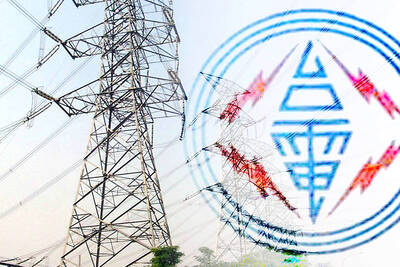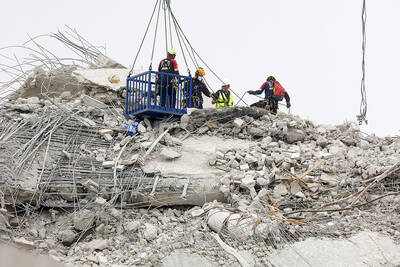Chinese contemporary artist Zhang Huan
(張洹) garnered an early reputation as somewhat of an enfant terrible of Beijing’s art world. In his breakout 12 Square Meters he examined the tortures of existence by smearing his naked body with fish oil and honey after which he sat for an hour in a
bug-infested latrine. The 1995 To Add One Meter to an Anonymous Mountain (為無名山增高一米) consisted of 10 naked bodies piled on the summit of Miaofengshan (妙峰山) west of Beijing, with nine artists later the same day simulating intercourse with a nearby peak.
Videos of these performance works are currently on view at the Museum of Contemporary Art, Taipei, and form part of a retrospective of Zhang’s oeuvre under the title Amitoufo (阿彌陀佛). The show provides a solid overview of the artist’s career, from his early existential investigations and social critiques to his later Buddhist-inspired sculptures and ash on linen paintings.
Trained as an oil painter at Beijing’s Central Academy of Fine Arts, Zhang became disenchanted by the limitations of the medium and began experimenting with performance art. At this time, Zhang and other like-minded Chinese artists established the Beijing East Village, which enabled
the burgeoning artist to explore his new direction.
But audiences and critics generally met his penchant to perform naked with bafflement or derision, so in 1998 Zhang moved to New York, an environment more amenable to his performance art.
Two videos at MOCA are representative of his New York period. The 1998 Pilgrimage — Wind and Water in New York (朝拜–紐約風水) shows a naked Zhang lying face down on a Ming-style bed that is covered with thick blocks of ice, while My America (Hard to Assimilate) (我的美國) features a naked Zhang sitting on a stool as 60 volunteers, also naked, pelt him with loaves of bread.
The videos suggest the isolation of recent immigrants to New York and subtly poke fun at the city’s (and America’s) multicultural presumptions.
Zhang returned to China and opened a studio in Shanghai in 2006. It was at this time that he became a practicing Buddhist — a spiritual transformation that has informed his work ever since.
Amitoufo’s curator, Yang Shin-Yi (楊心一), does a superb job of showing this remarkable change by juxtaposing Zhang’s revelatory performance videos with his religiously inspired sculptures.
Buddhist influences are manifest in the hanging leather sculpture Cowskin Buddha Face No. 4 (牛皮佛臉4號). The hide is shaped to form the face of Buddha and hints at the inseparable relationship between animal and human, flesh and spirit.
A more general examination of China’s religious heritage can be found in Chinese Civilian & Chinese Warrior (文化部長和國防部長). The 5m-tall sculptures of the gods of literature and war are embedded with Buddhist relics, offering dishes and unburned incense sticks, invoking the ritualistic aspects of religion and its appearance in Zhang’s artistic practice.
There is much else to see in Amitoufo: The 11 ash paintings that examine China’s history from the Republican period until 1970 offer an interesting statement about the country’s public memory and future. But the value of the exhibit lies in the curator’s ability to demonstrate how Zhang channeled the existential angst of his early performance art into the transcendent calmness of his later paintings and sculptures.

That US assistance was a model for Taiwan’s spectacular development success was early recognized by policymakers and analysts. In a report to the US Congress for the fiscal year 1962, former President John F. Kennedy noted Taiwan’s “rapid economic growth,” was “producing a substantial net gain in living.” Kennedy had a stake in Taiwan’s achievements and the US’ official development assistance (ODA) in general: In September 1961, his entreaty to make the 1960s a “decade of development,” and an accompanying proposal for dedicated legislation to this end, had been formalized by congressional passage of the Foreign Assistance Act. Two

March 31 to April 6 On May 13, 1950, National Taiwan University Hospital otolaryngologist Su You-peng (蘇友鵬) was summoned to the director’s office. He thought someone had complained about him practicing the violin at night, but when he entered the room, he knew something was terribly wrong. He saw several burly men who appeared to be government secret agents, and three other resident doctors: internist Hsu Chiang (許強), dermatologist Hu Pao-chen (胡寶珍) and ophthalmologist Hu Hsin-lin (胡鑫麟). They were handcuffed, herded onto two jeeps and taken to the Secrecy Bureau (保密局) for questioning. Su was still in his doctor’s robes at

Last week the Democratic Progressive Party (DPP) said that the budget cuts voted for by the China-aligned parties in the legislature, are intended to force the DPP to hike electricity rates. The public would then blame it for the rate hike. It’s fairly clear that the first part of that is correct. Slashing the budget of state-run Taiwan Power Co (Taipower, 台電) is a move intended to cause discontent with the DPP when electricity rates go up. Taipower’s debt, NT$422.9 billion (US$12.78 billion), is one of the numerous permanent crises created by the nation’s construction-industrial state and the developmentalist mentality it

Experts say that the devastating earthquake in Myanmar on Friday was likely the strongest to hit the country in decades, with disaster modeling suggesting thousands could be dead. Automatic assessments from the US Geological Survey (USGS) said the shallow 7.7-magnitude quake northwest of the central Myanmar city of Sagaing triggered a red alert for shaking-related fatalities and economic losses. “High casualties and extensive damage are probable and the disaster is likely widespread,” it said, locating the epicentre near the central Myanmar city of Mandalay, home to more than a million people. Myanmar’s ruling junta said on Saturday morning that the number killed had